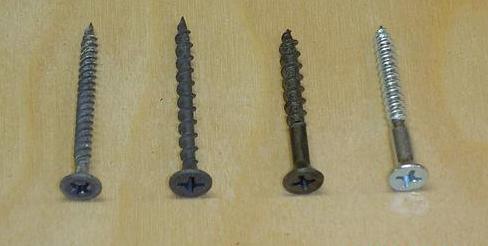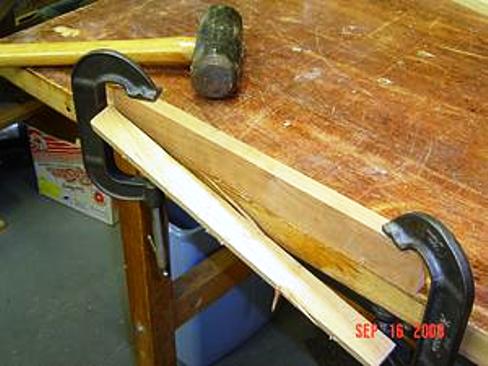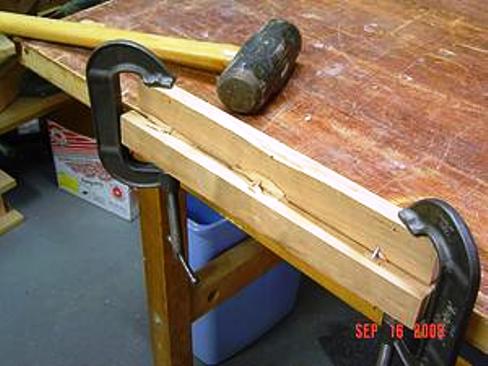Walk into most any hardware or Home Depot type store and invariably you’ll find boxes upon boxes of drywall screws but only a meager selection of woodworking screws. Not only that, the drywall screws cost much less than the woodworking screws. As a consequence, I suspect many a woodworker has pondered the question: “Can drywall screws be used for woodworking?” Well, let’s explore that question a bit…

Drywall and wood screws
The conventional wisdom seems to be that drywall screws are not suitable for woodworking projects because: a) they are too brittle and can snap off if over tightened or overstressed, b) their threads are not coarse enough to securely grip the wood, and c) because the entire shank is threaded, this can force the pieces apart rather than pulling them together.
There is some truth to all of these points but there’s more to the story. Drywall screws were originally developed to rapidly attach drywall to metal studs for commercial buildings. They came with metal piercing points and fine threads so they could self feed into metal studs without the need for pilot holes. It was all about speed and affordability (eventually, drywall screws were mass produced by the billions, reducing the unit cost to a pittance). Because they were designed to screw into steel, drywall screws are very hard, but also brittle. They will indeed snap off if you over tighten them. We’ve all been there. But more importantly, drywall screws can snap off if subjected to excessive stress in use. But what exactly is excessive stress?
To help answer this question, I decided to run a few highly scientific tests in the woodshop. I screwed together two pieces of scrap cherry using three 1-1/2″ drywall screws spaced about 10″ apart. I clamped the assembled boards to the workbench with the piece receiving the screw projecting over the edge of the bench. Then the fun began. I grabbed my trusty 8 lb sledgehammer and proceed to whale away on the projecting piece. After four solid blows (about a 1 foot drop), the drywall screws snapped off and the joint officially “reached a state of failure” as can be seen below. This was a clean break in that there was minimal splintering of the wood.

Drywall screw strength test
I then ran the sledgehammer test on two pieces of wood held together with wood screws. This time, the joint also failed after about 3-4 blows but the screws did not snap; instead, they bent and pulled loose from the wood after the wood splintered around the screws. In other words, the wood failed before the screws did.

Wood screw strength test
So, what was learned from this little experiment (other than to not beat on furniture with a sledgehammer)? In normal use, the average piece of furniture would not be subject to this kind of concentrated punishment. But if a joint is exposed to continuous stress over time, perhaps due to racking or moisture-related movement, the stress would impart lateral forces on the fasteners. I’m thinking of things like house framing, boats, drawer frames, step stools, chairs, and heavy-use storage shelves. Based on the results from this experiment, I would be leery of using drywall screws in such applications for fear the screws would fail.
On the other hand, I have used drywall screws many times for lower stress applications and never ran into snappage problems. These include case assemblies, woodworking jigs, display cases, end tables, and dog houses. And if drywall screws are combined with glue and dado construction, the chances of success are much higher since the screws don’t have to bear the entire brunt of the load.
What about drywall screws being too fine-threaded to securely grip into wood? Well, there are actually coarse-threaded drywall screws so what may once have been a concern is no longer. In fact, it seems that stores now carry more coarse-threaded drywall screws than fine-threaded ones. This is definitely the case if you include deck screws, close cousins of drywall screws.
The last issue has to do with the potential for drywall screws to not pull boards tight against each other. The story line here is that the upper screw threads will anchor in the top board and prevent the boards from pulling together unless they are tightly clamped. This can and does happen but in my experience, it is usually a non-issue as long as the boards are clamped together (aren’t most woodworking projects clamped together during assembly?) or if the pilot hole in the upper board is large enough to allow the drywall screw to fit without being too tight. Sort of how a wood screw pilot hole is made. Combine clamping with proper pilot hole drilling and board separation becomes very unlikely.
In conclusion: As long as drywall screws continue to be cheaper and more readily available than wood screws, I think an argument can be made for using them in situations where the screws are not exposed to excessive lateral stresses. Certainly, many non load-bearing furniture projects fall into this category. But, if you’re the least bit unsure or have safety concerns about screws snapping off, spending a bit more for wood screws is worth the piece of mind.


I do not like the bugle heads on dry wall screws as, unless you countersink, create craters like those on the moon. I like the alternative Fastenal as they drill themselves and have the ability to cut their own countersinks.
I’d like to mention that if drywall screws are used on an outdoor project or a project that may be in a high moisture environment, like it is often in ones garage here in Oregon, the screw heads will often stain the wood around them and can even cause streaking down from where they’re placed. Not to mention that the high moisture can and most always will eventually lead to rusting and therefore loss of integrity of the fastener itself. I have even seen this occur on spackled and painted projects that are exposed to the conditions mentioned above.
Interestingly it seems as though the tannins in cedar cause the fasteners to streak especially hard and black down from where they’re placed.
Good info – thanks for sharing. I suspect similar staining would happen with white or red oak.